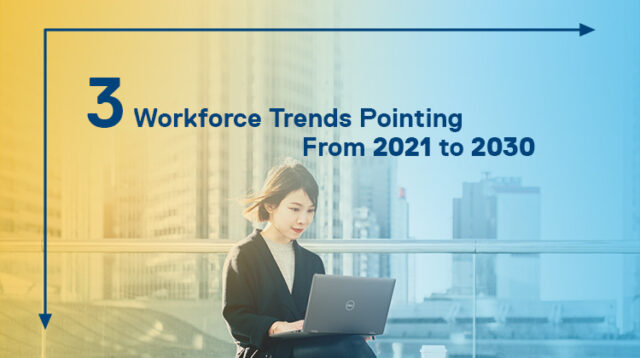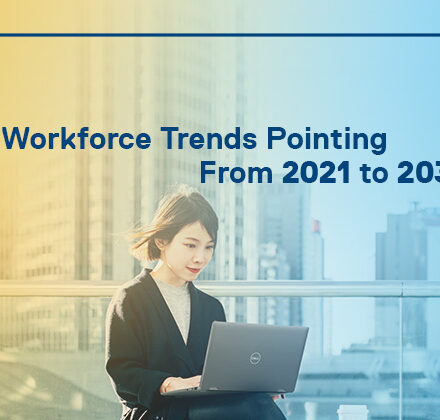The current work environment requires flexibility, new skills, and new ways of working. Technology continues to drive how and where people work…
That statement from a 2018 PwC report was still true in 2019 and heading into 2020 and even more true by mid-year 2020. The continuing impact of the pandemic and the increase in remote working is accelerating modern work requirements in 2021.
Three specific areas will make a continuing difference to the workforce, very possibly an increasingly significant difference, through the end of this decade: remote working, human-machine partnerships, and a more human work environment. We should be attentive to these areas now for the sake of Workforce 2030.
Workforce Trend #1 – Remote Working.
Restrictions implemented around the world caused many organizations to shift their workforces to working remotely, making them create and then adapt to virtual work situations. No matter whether a company had not yet started or was far along in its digital journey, that business was driven to move forward with increased digital operations. In almost every case, the need to provide tools and platforms, install new procedures, and support a virtual work culture required attention. In every case, those changes meant digital transformation.
At one extreme is the small business that is not digital. Many that were not digital early in 2020 quickly initiated digitalization efforts. A survey by SoftwareAdvice.com of 150 leaders of non-digital small businesses (NDSBs) found that 49% had implemented or planned to implement digital tools and platforms in order to alter their product or service lineup and to offer the curbside pickup option.
At the other end of the spectrum is the company advanced in implementing their digital future. While the trends below were already in motion, the global situation only hastened their efforts, increasing and accelerating implementation. The most digitally mature companies could and did rapidly transition to 100% virtual operations.
To whatever scale was realistic, organizations of every size and digital vitality implemented or accelerated technology-based changes. These are some of the changes
- Remote work arrangements full-time for the time being
- Digitalization of customer service to maintain customer value
- Greater use of self-service for both customers and employees
- Use of online and on-demand platforms to support the virtual workplace
Workforce Trend #2 – Artificial Intelligence (AI) Applications and Human-machine Partnerships.
The 2020 situation has brought attention to customer value, defined as the deliverable value from improved customer experience, from both businesses and customers. Artificial intelligence and machine learning (AI/ML) are now the key technologies to customer value. AI/ML applications optimize operations, reduce inefficiencies, drive data analysis, personalize marketing responses and more. This improves and increases the organizations customer value, which is why businesses are implementing AI applications at an ever-increasing rate.
Applications of AI and related technologies are now changing work and creating jobs. McKinsey’s estimate (2018) is that by 2030 as many as half of the work activities (not jobs) will be automated. This simply means that humans and machines will function side by side. Dell’s Realizing 2030 points out that more than 80% of business leaders expect humans and machines to be working as integrated teams by 2025.
Essentially, we’ve worked and lived alongside machines for centuries but by 2030, these partnerships will become deeper, richer and more immersive than ever before, helping us surpass our own limitations.
The increasing presence of AI and the resulting human-machine partnerships will give AI literacy relevance to how well each worker
- Performs their job
- Communicates with associates and customers
- Understands the relationship between AI and the company’s success
That places risk on the readiness of a company to develop that AI literacy as well as more technical AI skills and knowledge.
According to a 2018 study from Accenture, 61 percent of business leaders expect an increase in the number of roles requiring collaboration with AI by 2021, yet just three percent are planning significant investment in training and reskilling programs. (Dell, Building a Roadmap for Effective Reskilling…)
Workforce Trend #3 – A More Human Work Environment.
In 2021 and beyond, the changes discussed above will cause and contribute to three factors that facilitate an individual’s ability to work and to learn.
Empowerment is the first factor. Workers who are given the tools and skills to be productive demonstrate greater self-confidence and motivation. Technologies available today and in the future empower employees to show increasing productivity through 2030. A 2018 survey showed that 86% of global business leaders planned to use emerging technologies to improve their workforce productivity. In light of the likelihood that 2020’s increase in virtual work from anywhere will continue, dozens of technology applications will allow individuals to work smarter, faster, and virtually from anywhere.
Inclusiveness and diversity are the second factors, good for the business and for the workforce. AI can contribute directly to a workforce being more diverse and inclusive. Talent recruitment can suffer the unconscious bias of choosing the applicant who most resembles oneself. AI applications already at work apply “technology filters” that eliminate demographic clues from candidates’ resumes open the way for a more non-biased hiring decision. Eliminating systemic bias such as age, race, gender allows organizations to make talent selections based on capabilities individuals can bring to the job.
Learning critical knowledge and skills is the third factor. As 2021 powerful technologies with human capabilities, learning opportunities see now as valuable will be critical for the next 10-15 years. Such learning will integrate professional skills and digital knowledge, enabling individuals to maximize success from the human-machine partnership.
Call to Action
Realizing 2030: A Divided Vision of the Future shares global business leaders’ projections of their companies’ actions between now and 2030. These changes will set a dynamic context that powers (and reinforces) the three trends we have discussed.
- 85% foresee faster alignment of compensation, training, and KPIs with digital goals and strategies
- 85% anticipate accelerating implementation policies and technologies to support a remote, flexible workforce
- 81% plan to use AI to pre-empt customer demands
- 75% expect to appoint a Chief AI Officer
- 74% look to “automate everything” and encourage customers to self-serve
- 70% welcome human-machine partnerships
Embracing those changes successfully will require continuous attention to skills and knowledge, information and learning the workforce needs, now and throughout this decade.
To ready yourself, your team, or your organization starting this year and all the way to 2030, visit Dell Technologies Education Services. You will find extensive information on information, learning, and certification.
Sources
- Workforce of the Future: The Competing Forces Shaping 2030, PwC, 2018
- How COVID-19 Is Impacting the Digital Transformation Journey of Small Businesses, SoftwareAdvice.com, 2020
- How Instructor-led Training Became 100% Virtual, Cindy Etherington, 2020
- The Future Workforce Must be AI-Collaborative; Are You Ready?, Tim Wright, 2021
- Realizing 2030: A Divided Vision of the Future, Dell Technologies/Vanson Bourne, 2018
- Building a Roadmap for Effective Reskilling in the AI-Infused Workplace of Tomorrow, Stephanie Walden, 2019
- Emerging Technologies Are Impacting Work as Human-Machine Partnerships Accelerate, Dell Technologies, 2020
- Work at Full Speed Ahead, Dell Technologies, 2020
- Want a More Diverse Workforce?, Mark Stone, 2018
- AI and the Quest for Inclusive Talent, Oliver Christie, 2019
- 5 Crucial Skills Your Employees Will Need by 2030, Dell Technologies, 2017


